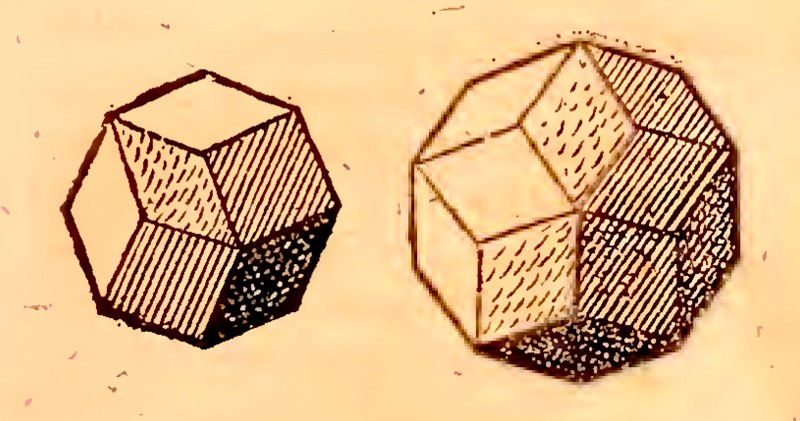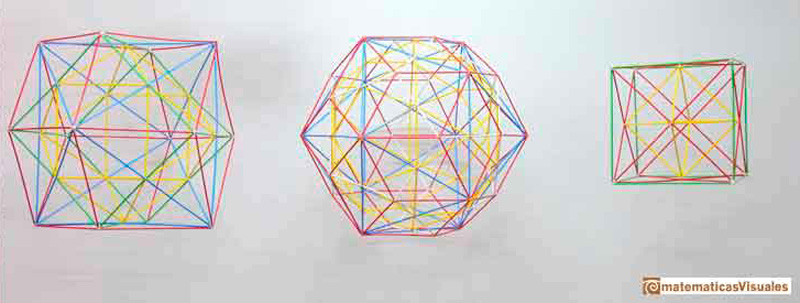- About MAA
- Membership
- MAA Publications
- Periodicals
- Blogs
- MAA Book Series
- MAA Press (an imprint of the AMS)
- MAA Notes
- MAA Reviews
- Mathematical Communication
- Information for Libraries
- Author Resources
- Advertise with MAA
- Meetings
- Competitions
- Programs
- Communities
- MAA Sections
- SIGMAA
- MAA Connect
- Students
- MAA Awards
- Awards Booklets
- Writing Awards
- Teaching Awards
- Service Awards
- Research Awards
- Lecture Awards
- Putnam Competition Individual and Team Winners
- D. E. Shaw Group AMC 8 Awards & Certificates
- Maryam Mirzakhani AMC 10 A Awards & Certificates
- Two Sigma AMC 10 B Awards & Certificates
- Jane Street AMC 12 A Awards & Certificates
- Akamai AMC 12 B Awards & Certificates
- High School Teachers
- News
You are here
Kepler and the Rhombic Dodecahedron: Conclusion – Kepler’s Other Rhombic Polyhedron Discovery
Kepler’s discovery of the rhombic dodecahedron by observing the base of bee cells marked the wonderful birth of a new polyhedron. He then showed that this rhombic dodecahedron was related to a technical problem: how best to pile up cannonballs. Next, he taught us perhaps the simplest way to understand the rhombic dodecahedron, as a cube augmented with pyramids. He also knew that the rhombic dodecahedron, like the cube, can be used to tessellate space.
Was his mind at rest following these discoveries? No, not at all.
Kepler wrote:
Intrigued by these rhombi [the rhombi from the bottom of bee cells], I began looking into geometry to see whether a body resembling the five regular solids and the fourteen]7] Archimedean solids could be constructed exclusively from rhombi. I discovered two, one related to the cube and the octahedron, the other to the dodecahedron and the icosahedron. (The cube itself can be considered a third, since it is like two tetrahedra joined together.) The first of these solids is contained by twelve rhombi, the other by thirty [Kepler 1611, 43 and 45].

Figure 32. Drawings of a rhombic dodecahedron and a rhombic triacontahedron, from Harmonices Mundi Book II, p. 61.
The second rhombic polyhedron that Kepler discovered, with thirty faces, is called the triacontahedron.
Figure 33. Three rhombic polyhedra: rhombic dodecahedron, triacontahedron, and cube (3d-printed models).
How did Kepler discover the triacontahedron after identifying the rhombic dodecahedron?
What are the relations between these two rhombic polyhedra?
Is the cube a third rhombic polyhedron only because its six faces are square, that is to say, a special kind of rhombus? Or is there a deeper connection between these three rhombic polyhedra?
The study of the triacontahedron and the answers to these questions deserve another article!
[7] It is interesting that Kepler wrote "Archimedeis quattuordecim" (which translates as "the fourteen Archimedean solids") here. As previously noted, he later showed that there are only thirteen such solids that satisfy the definition he gave in Harmonices Mundi. Although we don’t know why Kepler gave the number of Archimedean solids as 14 in his earlier work, it is possible that he was thinking of the pseudo-rhombicuboctahedron—this is the fourteenth polyhedron that distinguishes the two different definitions of Archimedean solids in use today (mentioned in footnote 6). As far as is known, Kepler never publicly reconciled his earlier statement in De Nive Sexangula with his later detailed enumeration in Harmonices Mundi.
Roberto Cardil (matematicasVisuales), "Kepler and the Rhombic Dodecahedron: Conclusion – Kepler’s Other Rhombic Polyhedron Discovery ," Convergence (March 2022)





